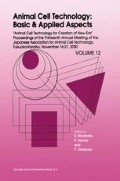Abstract
The degree of sialylation is a major issue in the development of therapeutic glycoproteins. In this study, the feeding of N-acetylmannosamine (ManNAc) to Chinese hamster ovary (CHO) cell cultures was investigated as a method of improving sialylation profile, using a model glycoprotein we call, “Glycoprotein X”. For the purpose, moreover, a simplified 4-step method for sialylation profile analysis was developed without the use of special or expensive equipment. The addition of ManNAc into the culture medium largely improved sialylation of Glycoprotein X in a dose-dependent manner up to 20 mM ManNAc.
Access this chapter
Tax calculation will be finalised at checkout
Purchases are for personal use only
Preview
Unable to display preview. Download preview PDF.
References
Cole, E. S., Nichols, E. H., Poisson, L., Harnois, M. L., and Livingston, D. J. (1993) Fibrinolysis 7, 15 - 22
Gu, X., Harmon, B. J., and Wang, D. I. C. (1997) Biotechnol. Bioeng. 55, 390 - 398
Gu, X.and Wang, D. I. C. (1998) Biotechnol. Bioeng. 58, 642 - 648
Kondo, A., Suzuki, J., Kuraya, N., Hase, S., Kato, I., and Ikenaka, T. (1990) Agric. Biol. Chem. 54, 2169 2170
Nakagawa, H., Kawamura, Y., Kato, K., Shimada, I., Arata, Y., and Takahashi, N. (1995) Anal. Biochem. 226, 130 - 138
Green, E. D., Adelt, G., and Baenziger, J. U. (1988) J. Biol. Chem. 263, 18253 - 18268
Mizuochi, T., Taniguchi, T., Shimizu, A., and Kobata, A. (1982) J. mmunol. 129, 2016 - 2020
Author information
Authors and Affiliations
Editor information
Editors and Affiliations
Rights and permissions
Copyright information
© 2002 Springer Science+Business Media Dordrecht
About this chapter
Cite this chapter
Oba, Y., Fletcher, T., Hisaka, M., Treat, W.J. (2002). Improvement of Sialylation in Chinese Hamster Ovary (CHO) Cell Culture by Feeding N-Acetylmannosamine. In: Shirahata, S., Teruya, K., Katakura, Y. (eds) Animal Cell Technology: Basic & Applied Aspects. Animal Cell Technology: Basic & Applied Aspects, vol 12. Springer, Dordrecht. https://doi.org/10.1007/978-94-017-0728-2_37
Download citation
DOI: https://doi.org/10.1007/978-94-017-0728-2_37
Publisher Name: Springer, Dordrecht
Print ISBN: 978-90-481-5934-5
Online ISBN: 978-94-017-0728-2
eBook Packages: Springer Book Archive

